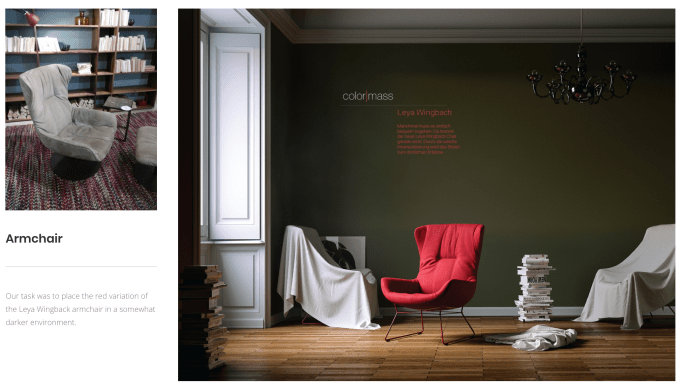Goodbye, photo studios. Hello, colormass virtual photoshoots

IKEA is a leader among those that have pushed the limits when it comes to using digital imaging to take product marketing to the next level. When you look at an IKEA catalog or its website, you might think you are looking at rooms full of Swedish sofas, coffee tables and stylish lamps, but you’re actually looking at highly realistic, but digitally manipulated 3D facsimiles — the same facsimiles that are now being used to build the next generation of retail: AR apps that let you select and place pieces in your own rooms to help figure out what to buy.
All this is pretty cool, but also potentially frustrating if you are a manufacturer, retailer or anyone else who is manufacturing or selling a tangible product: not everyone has the resources of an IKEA to create digital inventory like this. Until now.
Berlin-based colormass, one of the startups presenting today at TechCrunch Disrupt as part of the Battlefield, has developed a platform that lets you recreate an IKEA-style experience for your own merchandise.
A furniture company (or another business in the area of manufacturing) supplies its own production files, which are already created as part of a company’s manufacturing process; and it also supplies information regarding textures, colors and other variables related to the pieces. Then colormass uses computer vision algorithms to convert these images into lifelike, but fabricated, 3D files that can be altered with different textures and colors and subsequently embedded in different (equally virtual, not real) scenes, like this:

and this:

The resulting service is a fraction of what it would cost for a business either to create a system like the one used by, say, IKEA, or to build the various physical products and settings to shoot them in the more traditional way.
“Companies like IKEA use very sophisticated software to do this,” said Balint Barli, who co-founded colormass with Tas Solti and Benjamin Foldi. “We want to enable everyone to be able to do this without knowing anything about 3D. If you want to do what IKEA does, you used to need specialized hardware, expensive software and a lot of experience and training in 3D to be able to do it. Now you don’t.”
A lot of the computer vision developments that we’ve seen hit the market of late have been squarely focused on consumer apps: filters that give us faces like cute animals, or a new color of hair, or help place us into the thick of the action in video games.
Video games and consumer apps, in fact, were where colormass’s founders first got their start. Barli and Solti’s early work was in the area of 3D reconstruction technology, essentially recreating people’s faces so they could be used in video games and in other applications, like hair coloring.
That market is both crowded and, in a sense, becoming more commoditized, though, so they began to think of other places where the same computer vision technology could be applied.
The pair then teamed up with Foldi, whose experience was specifically in 3D imaging. “We quickly realized that the tech could go into a different direction, essentially in helping to make better and less expensive, but still high quality, marketing images and product design,” Barli said.
Barli said that colormass started working with furniture manufacturers in 2016, with current customers usually of the medium-sized variety with $100 million or more in revenue.
He said that customers (at least for now) do not like to be named. “Since these images look exactly like photos, they would like to keep the impression that they are actual images of the real objects.”
Colormass is interesting because it is addressing a clear gap in the enterprise market, helping to digitize “any kind of tangible product,” in the words of Barli. The idea will be to continue to augment this, for example with the ability to manipulate multiple products or images in a 3D room. But he also says that its B2B service for the design and home-goods communities is “only the mid-term goal.”
“The long-term goal is to aggregate all the digitized products to become one of the largest repositories of 3D assets, a library that can be used for product marketing, but also games and other VR and AR applications,” he said. “3D content is a big problem, because there just isn’t that much.” The company has already started building this, signing agreements with their customers to be able to keep certain images in colormass’s own database.
This opens some interesting doors for the company, making it either a competitive rival (or interesting complementary acquisition) not just for the Autodesks and Adobes of this world, but massive photo agencies like the Gettys, as well.